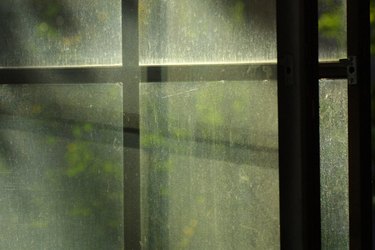Things You'll Need
External, clear silicone and paintable caulking
Caulking gun
Putty knife
Rag or brush

Window frame leaks can be a serious problem. In most cases, the cause is found in the seal, or caulking. Leaks are commonly seen in wood-framed windows because the wood contracts and expands as the temperature changes and humidity rises and falls. This causes the caulking to crack and fall away from the glass. Not only are water stains unattractive, but they can lead to mold and mildew growth -- which can pose serious health issues -- and structural problems as the wood rots from the moisture. Applying new caulking also stops air leaks in your windows, which can help you save on energy costs.
Step 1
Examine the caulking around the window frame where it meets the external wall for cracks and gaps. If it is crumbling, this is likely the cause of the leak and the window will have to be re-caulked.
Video of the Day
Step 2
Scrape away the remains of the old caulking and clean the surface with a rag or brush.
Step 3
Place a tube of external caulking in a caulking gun. Start at one of the top corners of the window and smoothly apply the caulking along the seam where the window frame meets the wall. Hold the gun at a 45-degree angle and use a steady pressure on the trigger.
Step 4
Flatten the line of caulking with a putty knife.
Step 5
Caulk the four corners of the frame, where each piece of wood meets the other. Although vinyl-framed windows are one piece, wood-framed windows have four pieces that can leak at the joints.
Step 6
Move indoors and apply caulking around the inner edges of the window, where the glass meets the wood. Use clear silicone caulking for this step, as you will be working next to the glass.
Step 7
Caulk around the window sill and underneath it. Do this also for trim pieces if the window has decorative wood trim. Use paintable caulking so you can paint both the wood and the caulking later.
Tip
If caulking doesn't solve the problem, then the leak is probably not originating in your wood frame. Instead, it may be coming from a structural issue in your roofing, in your walls or from the eaves above your window.
Video of the Day